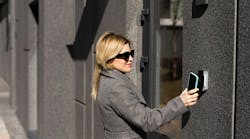In just a few years’ time, the terms “remote” and “hybrid workforce” have become a part of our vernacular, as many companies pivot to the new normal of having some, and in many cases, all their employees working remotely from home. This has created a shift in how companies, property owners and businesses are securing their commercial building spaces.
As Joshua Sands, owner of Key City Locksmith and Security, based in Kansas, points out, COVID changed the way people looked at security, and in the process hastened the adoption of electronic locks and connected technologies like video analytics and artificial intelligence (AI). “People didn’t want to touch things, which gave a bigger push for automated systems,” Sands points out. “More places needed security systems and security systems got more complex because now you have remote jobs, so your storefront may still work there, but it's more of a skeleton crew now, or more mobile-based pick-up and delivery.”
Sands is smart to point out that what was maybe prohibitive budget-wise in the past, is now becoming an operational expenditure (OPEX), not an afterthought, since COVID.
“There was a hard to push to electronics, but it wasn't necessarily affordable on the residential side, and the commercial side, while they could afford it, they didn't spend money unnecessarily, especially if they perceived it as a convenience factor. Now, because of COVID, corporate has changed drastically – no more keys – too many people are not coming into the office, or don't come into work steadily, or there’s high turnover … so many factors.”
Antoinette King, founder at Credo Cyber Consulting LLC, and director regional sales east and head of cyber convergence at i-PRO Americas Inc., agrees that COVID pushed everyone’s acceptance of new technologies such as to the cloud, AI, biometrics, and automation.
“Yes, [COVID] definitely fast tracked it,” says King, who has also spent time at Axis Communications, giving her a unique perspective into the integration of access control, video surveillance and cyber hardening. “Before COVID, zero trust was this mythical thing that nobody thought we could achieve. And then COVID hit and the next thing you know, everything's a zero-trust environment. So, it was like all these people said, ‘we can't do that, there's no way we don't have the funding,’ and then, magically, the wand was waived and zero trust was real. I do believe that out of necessity comes innovation, and that's exactly what happened.”
Getting High-Tech
Advancements in technology, such as the use of edge analytics in cameras, and AI, are not only helping to verify what is going on in and around the perimeter and doors, but also automating a response.
“AI technology is giving people the opportunity to be more proactive,” says King. “So, objects left behind, scene change, loitering, things like that, whereas before we were using AI more for forensic search. So, before it was more reactive, which I think is important and it's a big part of our ecosystem in terms of being able to do faster searches and solve crimes and things like that much faster. But now, AI is giving us the opportunity to also be proactive, not only from a security perspective, but from a customer experience perspective. For example, we're seeing specifically with some of the i-PRO Analytics, for example, in Europe they're using the scene change analytic for stocking shelves at a grocery store, so it is tied to all kinds of things that could be important to a business.”
Sands agrees that there is an increasing need for “artificial intelligence and security to work side by side with your security hardware so that you can leave your business unattended without risking security,” he says. “And cameras and alarms are great, but in the past, they've always been just a notifier; now, with the integration of AI, our systems specifically that we sell can let you know, of course, that something's happening, but also automatically determine what type of crime is being committed. Is this arson? Is this a burglary? An intruder?”
He continues, “You know what's going on now without even asking. AI can determine what type of response is needed and automate a response, so if the building is on fire, to call the fire department, or if there is a person trying to break into the front door, to call the police.”
Systems are so complex today that they can not only see that a person with a concealed firearm is coming into the building but also understand that there is a need to escalate the situation to the police. “You'll still be notified, of course, but instead of notifying you and then notifying the police or local agencies and letting them determine it, our cameras and security systems are smart enough to make that determination for them and let them know exactly what's going on,” Sands explains.
This gives the police and other emergency personnel much more information than ever before, allowing them to respond in a timelier and more precise manner, where seconds can make all the difference.
“We have seen through the industry the utilization of AI in schools,” says Sands, who notes that with the combination of cameras, locks and notification systems tied to AI, for example, can help determine much sooner if an assailant has a weapon, and what type of weapon it is, etc., many times with more accuracy that the human eye.
King agrees, noting, “It's really incumbent on us as the professionals to be able to tell that story around the value of using the technology to supplement the human element of security because we just don't have enough human resources at this point.” She astutely points out that New York City, for example, is now at approximately 30,000 police officers, down from 70,000 pre-COVID.
These technological advancements have also led to a decrease in false alarms, an ongoing bugaboo for many cities, spurring never-ending increases in fines for businesses and building owners who are repeat offenders.
“We've seen a huge reduction in false alarms,” says Sands. “We started out with cities implementing false alarm projects, like Cry Wolf which is a big one that is used, and it has helped a little, but AI technology has really come a long way to help identify exactly what's going on.”
Mechanical Still Needed
While there is a continued push toward electronic access that is integrated with other technologies, Sands is still seeing a huge need for mechanical access, not only to make sure the right locks are installed and working properly, but also meet state or federal regulations. For example, Sands is seeing a big demand for stronger security measures at medical cannabis dispensaries, due not only to stronger regulations but also to prevent theft. This has spurred increased efforts to fortify all doors of a building.
“That's actually written into a lot of laws and many jurisdictions I've researched in the areas we work require on many of your exterior doors that are not to the front of the building – rear entrances or exits – that the Trident locking device be put in place, not just a lever or a mortise mechanism,” notes Sands. “We've installed a lot in cannabis places, cell phone stores, retail, and other locations, for example, that require a higher level of security. So, electronic access is great, but there's still a huge demand on the mechanical side, and as a result we've gotten a lot more progressive with the mechanical security solutions and options.”
In addition to reinforced door hardware like Securitech’s Trident device on doors, Sands is seeing requirements for stronger safes for cannabis facilities. “In the last five years, in the cannabis industry, a lot of states are starting to dictate the type of safe that is needed,” he explains. “We are talking about really good safes – like TL-30 safes that jewelry stores and banks use – are sometimes being required in certain areas of this country for cannabis facilities, just like the Trident on the doors.”
Sands refers to a popular video on the company’s website of a test being done on a door using the Trident that included a large truck backing into the steel door that had Trident. They were unsuccessful.
Education and Training Key
As Vice-President and Director of Education for the Missouri-Kansas Locksmith Association, Sands works with locksmiths who are interested in expanding their knowledge of electronic locks and systems.
“I see a big resistance to the electronic world,” says Sands. “But it's coming, you know, so get ready for it or get left behind because in the next 20 years or so, you won't be able to pay your bills just doing rekeys and locking. So, you’ve got to know some basic electronics.”
He continues, “I'd like to see a bigger push into the electronic side of things. My focus as the Director of Education Missouri Kansas Locksmith Association is on providing training so it's not so scary to other locksmiths out there. So, (we are) training locksmiths and business owners here in the Kansas City area on how to install some of these systems better. Even some of the simple stuff, like a continuous hinge. We just did a class a month ago, and several people had never installed one, and that's been around for 50 years.”
King is also a big proponent for education, giving a lot of her time to attend conferences and lead sessions on these important topics, as well as sit on several advisory boards and committees. She was recently recognized as one of the top 100 cybersecurity influencers.
“What are we doing to invest in the education of our technicians and the people doing the installs to keep them up to par with what the industry is doing?” she asks. “Nothing! So, when they're installing the wireless locksets and the Bluetooth locksets, they're not putting any controls in place to prevent somebody from being able to go and intercept or steal that credential to unlock that door.”
She continues, “And then there is the element of remote connectivity where we are starting to service products remotely, but then also be able to remotely see our cameras through phones and other applications, which started to introduce this layer of risk that nobody really was mitigating or paying attention to.”
Future Credential
Because the industry is now integrating other solutions that are not security related, such as business intelligence-type of analysis, “identity and access management doesn't just mean a card presented at a door, but now that same credential potentially could get you into your computer and single sign on and things like that,” King explains.
Looking at a future credential that can be widely accepted and secure, King points to the Sentry biometric smart card from Sentry Enterprises as a direction she sees it all going. “I sit on their [advisory] board because I truly believe in their technology,” she says. “What they have is self-sovereign identity, where all the credentials reside with the user, and their biometric unlocks the authentication and verification at the same time. I believe we're going to transition to that type of a universal, password-less credential that is cyber-hardened.”
The goal, she asserts, is “to end up frictionless.”





